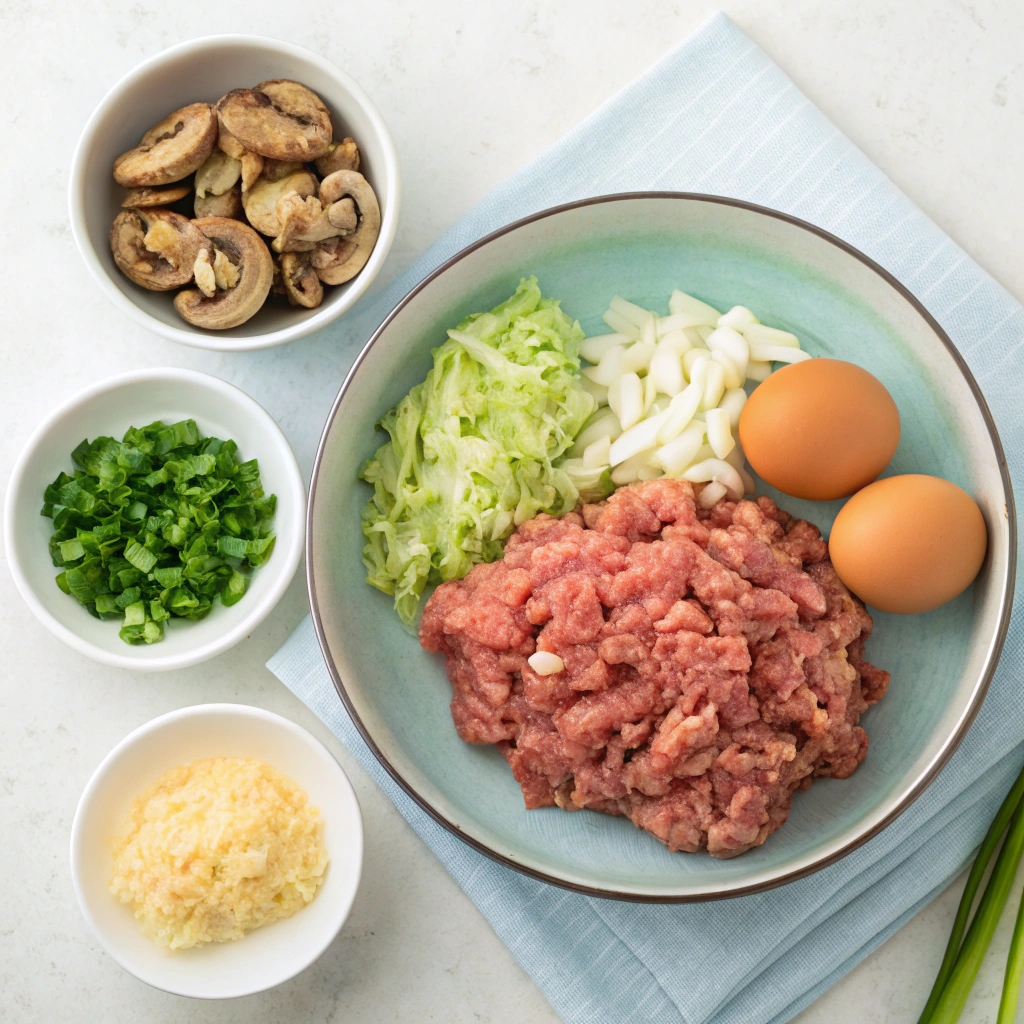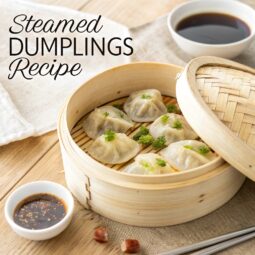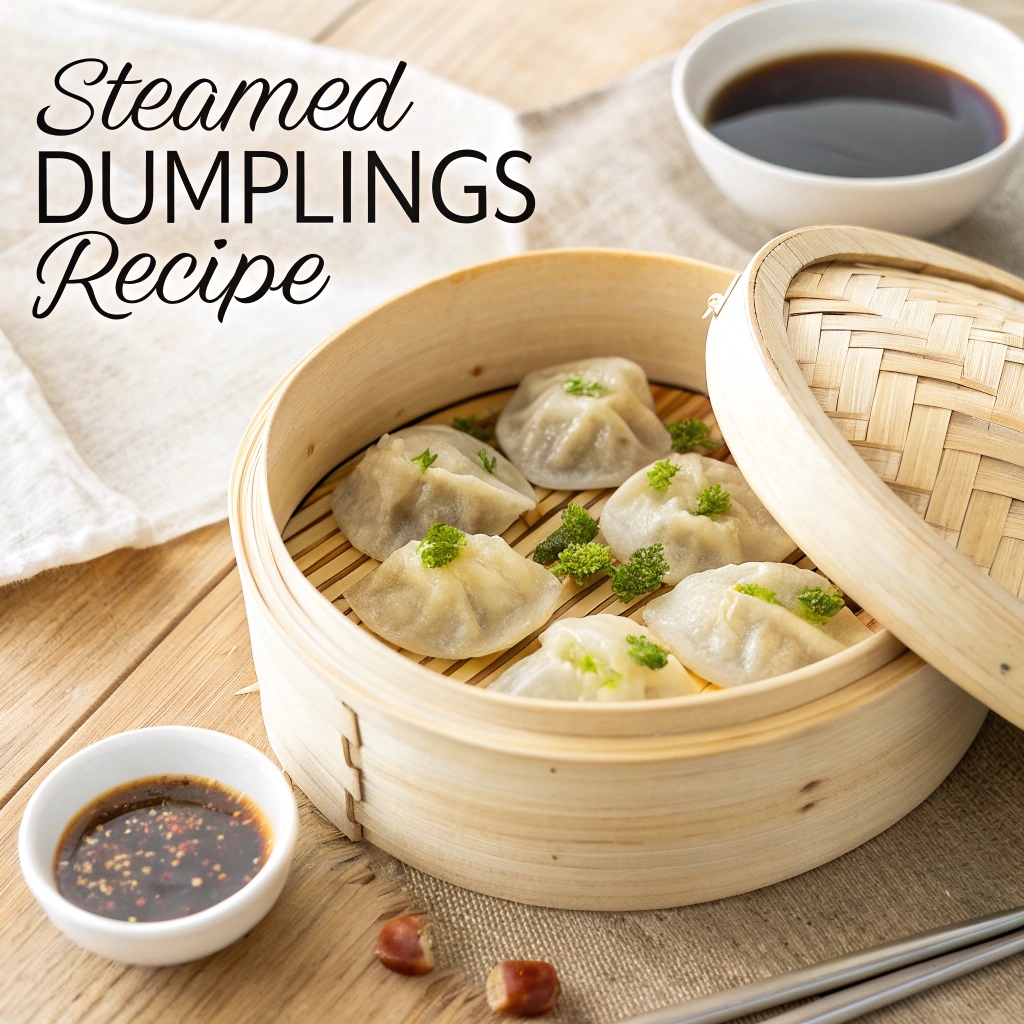These tender, juicy steamed dumplings are easier to make than you think! With store-bought wrappers and a flavorful pork and vegetable filling, you’ll have restaurant-quality dumplings on your table in just 30 minutes. The secret lies in the perfect balance of ginger, garlic, and sesame oil that makes each bite absolutely irresistible.
Why This Steamed Dumplings Recipe Works?
The Secret to Perfect Steamed Dumplings
The magic of great steamed dumplings starts with understanding the science. Unlike their pan-fried cousins, steamed dumplings use hot water dough (烫面) that creates an incredibly tender wrapper. When you steam dumplings instead of frying them, the gentle moist heat preserves the natural juices of the filling while creating that signature soft, slightly chewy texture Chinese restaurants are famous for.
I discovered this technique while researching traditional Asian cooking methods, and it completely transformed my dumpling game. The hot water partially cooks the flour proteins, resulting in a dough that’s easier to work with and stays tender even after cooling.
What Makes This Recipe Special?
This steamed dumpling recipe stands out because it solves the three biggest challenges home cooks face: soggy bottoms, dry filling, and complicated folding. By using the right wrapper-to-filling ratio and proper steaming technique, you get consistently perfect results every time.
The filling combines ground pork with crisp vegetables and aromatic seasonings, creating layers of flavor in every bite. Plus, I’ll share professional tricks for preventing common mistakes, ensuring your dumplings turn out restaurant-quality even on your first try.
Ingredients You’ll Need

Main Ingredients (Why Each Matters)
For the Filling:
- 1 lb ground pork (80/20 ratio): The fat content keeps dumplings juicy during steaming
- 1 cup napa cabbage, finely chopped: Adds moisture and subtle sweetness
- 3 shiitake mushrooms, diced: Brings umami depth (similar to our mushroom quinoa fried rice)
- 2 green onions, minced: Fresh, mild onion flavor without harshness
- 1 tablespoon fresh ginger, grated: Essential aromatic that cuts through richness
- 2 cloves garlic, minced: Builds savory foundation
- 1 egg: Binds the filling and adds richness
For Seasoning:
- 2 tablespoons soy sauce: Salty, umami base flavor
- 1 tablespoon sesame oil: Nutty aroma that’s distinctly Asian
- 1 teaspoon cornstarch: Helps filling hold together and retain juices
- ½ teaspoon white pepper: Traditional Chinese spice, more floral than black pepper
- ¼ teaspoon salt: Enhances all other flavors
For Assembly:
- 40 round dumpling wrappers: Store-bought saves time without sacrificing quality
- Water for sealing: Creates the glue that keeps dumplings closed
Pantry Staples
You probably already have these flavor boosters:
- Sesame oil (toasted variety preferred)
- Soy sauce (low-sodium works great)
- Rice vinegar for dipping sauce
- Fresh ginger (or 1 teaspoon ground)
- Cornstarch or potato starch
Best Substitutions That Actually Work
Protein swaps:
- Ground chicken thigh (not breast – too lean)
- Firm tofu, crumbled and pressed
- Ground turkey with extra sesame oil
- Shrimp, chopped fine (reduce cooking time by 2 minutes)
Vegetable alternatives:
- Regular cabbage for napa (blanch first)
- Bok choy, finely chopped
- Carrot, grated fine
- Water chestnuts for crunch
Wrapper options:
- Round gyoza wrappers work perfectly
- Square wonton wrappers (fold into triangles)
- Homemade hot water dough (recipe in tips section)
Essential Equipment
Bamboo Steamer (10-12 inch): The traditional choice that allows moisture to escape, preventing soggy bottoms. The natural material adds subtle aroma too.
Large Wok or Deep Skillet: Needs to fit your steamer with 1-2 inches clearance underneath for water.
Parchment Paper or Cabbage Leaves: Line the steamer to prevent sticking. Cut parchment into circles with holes punched for steam circulation.
Small Bowl of Water: For sealing wrapper edges – keep it nearby while assembling.
Clean Kitchen Towel: Cover assembled dumplings to prevent drying while you work.
Alternative Equipment:
- Metal steamer insert works fine
- Rice cooker with steaming basket
- Instant Pot with steamer rack
- Collapsible silicone steamer
Step-by-Step Instructions
Preparation Steps (15 minutes)
1. Prepare your vegetables: Remove excess moisture from cabbage by squeezing in a clean towel – this prevents soggy dumplings. Dice mushrooms into ¼-inch pieces for even distribution. Mince ginger and garlic together to release maximum flavor.
2. Mix the filling: Combine ground pork with all vegetables and seasonings in a large bowl. Mix gently with chopsticks or a fork in one direction for 2 minutes until the mixture becomes slightly sticky. This develops the proteins for better texture.
3. Test the seasoning: Microwave a teaspoon of filling for 30 seconds and taste. Adjust salt or soy sauce as needed – the flavors will concentrate during steaming.
4. Set up your station: Arrange wrappers, filling, water bowl, and a baking sheet lined with parchment. Having everything within reach makes assembly smooth and efficient.
Cooking Process (15 minutes)
1. Fill and fold dumplings: Place 1 heaping teaspoon of filling in the center of each wrapper. Avoid overfilling – it’s better to have less filling than risk bursting. Wet the edges with water using your finger.
2. Create the pleats: Hold the dumpling in your palm and create 3-4 pleats on one side, pressing to seal against the unpleated side. The classic crescent shape isn’t just pretty – it creates more surface area for flavor.
3. Prepare the steamer: Line bamboo steamer baskets with parchment circles or cabbage leaves. If using parchment, punch holes with a skewer for steam circulation.
4. Arrange for steaming: Place dumplings ½ inch apart – they expand slightly during cooking. Work in batches rather than overcrowding, which causes uneven cooking.
5. Steam to perfection: Bring 1-2 inches of water to a rolling boil in your wok. Place steamer on top, ensuring water doesn’t touch the bottom. Cover and steam for 12-15 minutes for pork, 8-10 for vegetables only.
How to Know When It’s Done?
Visual cues: The wrappers transform from opaque white to slightly translucent, with a glossy sheen. You should see the filling’s color through the wrapper.
Touch test: Gently press the dumpling – it should feel firm but give slightly, like a stress ball. Undercooked dumplings feel too soft; overcooked ones feel hard.
Internal temperature: For meat fillings, insert a thermometer into the center – it should read 165°F (74°C). For shrimp, look for pink color throughout.
Steam quality: Consistent, vigorous steam throughout cooking ensures even results. If steam weakens, add more boiling water to the wok.
Pro Chef Tips for Success
Common Mistakes and How to Avoid Them
Soggy bottoms: Never let dumplings sit in accumulated moisture. Serve immediately or transfer to a dry plate. Using cabbage leaves instead of parchment helps absorb excess water.
Dry, tough wrappers: This happens when dumplings cool uncovered. Keep them in the steamer with heat off until serving, or cover with a damp towel.
Burst dumplings: Usually from overfilling or poor sealing. Less is more – aim for plump but not stuffed. Make sure edges are completely dry before sealing.
Sticking together: Leave space between dumplings and lightly oil the steamer surface. They expand about 10% during cooking.
Uneven cooking: Maintain consistent water level and strong steam. Rotate steamer baskets halfway through if stacking multiple layers.
Make-Ahead and Scaling Guide
Freezing uncooked dumplings: Arrange on parchment-lined baking sheets, freeze until solid (2 hours), then transfer to freezer bags. They keep for up to 3 months. Steam directly from frozen, adding 3-5 minutes cooking time.
Refrigerator storage: Assembled raw dumplings last 24 hours covered in the fridge. Dust with cornstarch to prevent sticking.
Scaling up: This recipe doubles or triples easily. Mix filling in batches to ensure even distribution. Set up an assembly line with family or friends – it’s a fun activity like making edamame dumplings.
Reheating cooked dumplings: Steam for 3-4 minutes until heated through. Microwaving makes them rubbery, so always re-steam for best texture.
Troubleshooting Guide
Wrappers tearing during assembly: Let refrigerated wrappers come to room temperature. Work with one at a time, keeping others covered with plastic wrap.
Filling leaking during cooking: Check for small tears in wrappers. Ensure complete sealing, especially at pleat corners where gaps commonly form.
Dumplings sticking to steamer: Increase oil on steamer surface or use thicker cabbage leaves. Parchment works but needs proper perforation.
Bland filling: Don’t skip the sesame oil – it carries flavor throughout. Increase ginger and white pepper for more punch. Soy sauce amount can vary by brand saltiness.
Storage and Reheating
Refrigerator storage: Place cooked dumplings in an airtight container with parchment between layers. They keep for 3 days maximum. The wrappers firm up when cold, so reheating properly is crucial.
Freezing cooked dumplings: Cool completely first, then freeze in single layers before combining in freezer bags. Use within 1 month for best quality.
Best reheating method: Always re-steam rather than microwave. Set up steamer as for cooking, but steam for just 5 minutes until heated through. This restores the tender texture.
Avoid these methods: Microwaving creates tough, chewy wrappers. Pan-frying cooked steamed dumplings makes them greasy. Boiling causes them to fall apart.
Recipe Variations
Dietary Adaptations
Vegetarian steamed dumplings: Replace pork with crumbled firm tofu or chopped mushrooms. Our ginger noodles with shiitakes inspired this variation. Add extra vegetables like carrots, water chestnuts, and bamboo shoots for texture.
Gluten-free option: Use rice paper wrappers or make dough with rice flour and tapioca starch. These cook faster – reduce steaming time to 8 minutes.
Low-carb version: Use thin slices of daikon radish or cabbage leaves as wrappers. These create delicate, healthy dumplings perfect for keto diets.
Shrimp and pork (har gow style): Combine ½ pound each of shrimp and pork. Add bamboo shoots for crunch. These cook in just 10 minutes.
Seasonal Variations
Spring: Fresh pea shoots, asparagus tips, and young ginger create bright, delicate dumplings celebrating the season.
Summer: Sweet corn, zucchini, and fresh herbs like cilantro and Thai basil make light, refreshing fillings.
Fall: Butternut squash, wild mushrooms, and sage create hearty dumplings perfect for cooler weather.
Winter: Hearty combinations with root vegetables, preserved mustard greens, and warming spices like star anise.
International Twists
Korean-inspired: Add kimchi and gochujang to the filling, similar to mandu. Serve with spicy-sweet dipping sauce.
Japanese gyoza style: Use thinner wrappers and add more garlic. These are traditionally smaller with a higher wrapper-to-filling ratio.
Thai fusion: Incorporate lemongrass, kaffir lime leaves, and fish sauce. Serve with sweet chili dipping sauce.
Indian samosa dumplings: Fill with spiced potatoes, peas, and paneer. Season with garam masala and serve with mint chutney.
Nutritional Benefits
Steamed dumplings offer a healthier alternative to fried versions while delivering satisfying flavors. One serving (6 dumplings) contains approximately 280 calories, with 15g protein from the pork filling. The steaming method requires no added oils, reducing fat content by 40% compared to pan-fried potstickers.
The vegetable content provides fiber, vitamins, and minerals. Napa cabbage delivers vitamin C and K, while shiitake mushrooms offer B vitamins and immune-supporting compounds. Using whole ingredients means you control sodium levels, unlike restaurant versions that often contain 1000mg+ per serving.
For even healthier options, increase the vegetable-to-meat ratio or try our plant-based fillings. The protein keeps you satisfied while the complex carbohydrates from the wrappers provide sustained energy.
Perfect Pairings
Classic accompaniments: Serve with Chinese black vinegar mixed with julienned ginger. Add a drop of sesame oil and chili oil for complexity. Soy sauce alone is too one-dimensional.
Soup pairings: A simple clear broth with bok choy and ginger complements without competing. Hot and sour soup provides contrasting flavors that cleanse the palate.
Vegetable sides: Try our kohlrabi slaw for crunchy contrast. Stir-fried snow peas or garlic green beans add color and nutrition.
Modern twists: Pair with craft beer (wheat beers work wonderfully) or crisp white wines like Grüner Veltliner. Jasmine tea remains the traditional choice for good reason.
Complete meal ideas: Create a dim sum spread with spring rolls, sesame-ginger chickpea cakes, and steamed buns. Or keep it simple with just dumplings and a vibrant Asian salad.
Frequently Asked Questions
What’s the difference between steamed vs pan fried dumplings?
Steamed dumplings have soft, tender wrappers and preserve the filling’s natural juices, making them lighter and allowing flavors to shine. Pan-fried dumplings (potstickers) have crispy bottoms with contrasting textures but contain more oil. Nutritionally, steamed versions have 40% less fat and fewer calories.
Can I make steamed dumplings without a bamboo steamer?
Absolutely! Use a metal steamer insert, rice cooker with steaming tray, or even a heat-proof plate elevated on an inverted bowl inside a covered pot. The key is allowing steam to circulate while preventing water from touching the dumplings.
Why are my steamed dumpling wrappers tough?
This usually happens from overcooking or using cold water dough instead of hot water dough. Store-bought wrappers work best when brought to room temperature before use. Also, serve immediately – wrappers toughen as they cool and dry out.
How do I prevent dumplings from sticking to the steamer?
Line your steamer with napa cabbage leaves, parchment paper with holes, or lightly oil the surface. Avoid overcrowding – dumplings expand during cooking and will stick if touching. Cheese cloth works but can be harder to remove.
What’s the best steamed dumplings recipe from scratch?
While homemade wrappers are rewarding, quality store-bought wrappers save time without sacrificing taste. Focus your effort on the filling – that’s where flavor develops. If making wrappers, use 2 cups flour with ¾ cup boiling water for tender results.
Can I freeze assembled raw dumplings?
Yes! This is ideal for meal prep. Freeze on parchment-lined trays until solid, then transfer to bags. They keep 3 months and steam beautifully straight from frozen – just add 5 minutes cooking time.
What makes authentic Chinese steamed dumplings?
Traditional versions use hot water dough, minimal but quality ingredients, and time-tested folding techniques. The filling balances meat, vegetables, and aromatics without overwhelming any component. Authenticity comes from technique more than specific ingredients.
Conclusion
Making perfect steamed dumplings at home is easier than you might think. With the right techniques and a bit of practice, you’ll create tender, juicy dumplings that rival your favorite restaurant. The key is understanding how steaming differs from other cooking methods and embracing the gentle approach that makes these dumplings so special.
Whether you stick to the classic pork filling or experiment with creative variations, these dumplings bring people together. Set up a dumpling-making station for your next gathering – it’s an activity everyone enjoys.
Ready to start your dumpling journey? Grab your ingredients and let’s create something delicious. Once you master this easy steamed dumpling recipe, you’ll never order takeout dumplings again. Your family will be begging for these homemade treasures every week!
For more Asian-inspired recipes, try our veggie sushi with sunflower miso or explore other appetizers perfect for sharing. Happy steaming!

Easy Steamed Dumplings
Equipment
- Bamboo Steamer (10-12 inch)
- Large wok or deep skillet
- Parchment paper
- Small bowl for water
- Clean kitchen towel
Ingredients
For the Filling
- 1 pound ground pork (80/20 ratio)
- 1 cup napa cabbage, finely chopped and squeezed dry
- 3 shiitake mushrooms, diced fine
- 2 green onions, minced
- 1 tablespoon fresh ginger, grated
- 2 cloves garlic, minced
- 1 large egg
For the Seasoning
- 2 tablespoons soy sauce
- 1 tablespoon sesame oil
- 1 teaspoon cornstarch
- 1/2 teaspoon white pepper
- 1/4 teaspoon salt
For Assembly
- 40 round dumpling wrappers (store-bought)
- Water for sealing edges
- Cabbage leaves or parchment paper for lining steamer
Instructions
- Remove excess moisture from cabbage by squeezing in a clean towel – this prevents soggy dumplings. Dice mushrooms into 1/4-inch pieces for even distribution. Mince ginger and garlic together to release maximum flavor.
- Combine ground pork with all vegetables and seasonings in a large bowl. Mix gently with chopsticks or a fork in one direction for 2 minutes until the mixture becomes slightly sticky. This develops the proteins for better texture.
- Microwave a teaspoon of filling for 30 seconds and taste. Adjust salt or soy sauce as needed – the flavors will concentrate during steaming. The filling should be well-seasoned but not overly salty.
- Arrange wrappers, filling, water bowl, and a baking sheet lined with parchment. Having everything within reach makes assembly smooth and efficient. Keep wrappers covered with plastic wrap to prevent drying.
- Place 1 heaping teaspoon of filling in the center of each wrapper. Avoid overfilling – it’s better to have less filling than risk bursting. Wet the edges with water using your finger.
- Hold the dumpling in your palm and create 3-4 pleats on one side, pressing to seal against the unpleated side. The classic crescent shape creates more surface area for flavor. Ensure edges are completely sealed.
- Line bamboo steamer baskets with parchment circles or cabbage leaves. If using parchment, punch holes with a skewer for steam circulation. Lightly oil the surface to prevent sticking.
- Place dumplings 1/2 inch apart in the steamer – they expand slightly during cooking. Work in batches rather than overcrowding, which causes uneven cooking. Cover assembled dumplings with a damp towel.
- Bring 1-2 inches of water to a rolling boil in your wok. Place steamer on top, ensuring water doesn’t touch the bottom. Cover and steam for 12-15 minutes for pork filling, maintaining vigorous steam throughout.
- The wrappers should transform from opaque white to slightly translucent with a glossy sheen. Internal temperature should reach 165°F (74°C) for meat fillings. Dumplings should feel firm but give slightly when pressed.
- Transfer dumplings to a serving plate or serve directly in the steamer. Enjoy immediately while hot with Chinese black vinegar mixed with julienned ginger, or your favorite dipping sauce.

